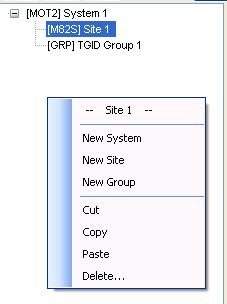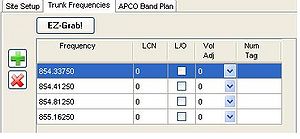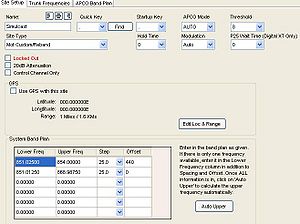Freescan Create Site
From The RadioReference Wiki
This screen can only be accessed after a system has been defined. FreeScan will create a single site along with the system. To define another site within a system, make sure the cursor is on the original site then right click. The screen at right appears. You can also access this form by clicking on the 'new site' button in the toolbar.
It should be noted that the concept of a 'site' is only applicable to the BCD996T, BCT15, the XT and P2 series scanners. These scanners may have 256 sites per system. For all other DMA scanners, this screen should be viewed as an extension of the system screen. Please see the Uniden Multi-Site Trunking article for a brief explanation of this feature.
For those scanners that use sites, you can now drop and drag a site from one system to another. The process is simple;
- Open up the sending and target systems (makes it easier to see what's going on)
- Right click on the desired site to move (ignore the menu that pops up)
- Drag the site to the desired system and release mouse
Site Setup
Click on images to expand
(Figure 1)
- Name: - the name of the system, as assigned during import functions or when the site is defined manually.
- If you use the RR import function, and the name has an asterisk next to it, hover the mouse over it to see the imported site notes
- Quick Key - For the BCD996, BCT15 and the XT scanners. The Site Quick Key (SIQK) assigned to this system. The Find Free button will attempt to find the next available SIQK to be assigned, however you can override this with the pulldown
- Startup Key - BCD996, BCT15 and the XT scanners. Enables the scanner to power up using only site defined with this key. To enable this function, press the appropriate keys for the desired site when powering up. Can apply to systems, sites or searches. See the Easier to Read manual for your scanner
- APCO Mode- BCD396T, BCD996T, BCD396XT and BCD996XT only - Sets the mode the scanner uses for P25 decoding.
- AUTO - Adjusts the threshold to match the transmission if the signal is strong and has a high decode rate
- MAN - The user can adjust the threshold
- DFLT - The default setting as determined by the scanner.
- Threshold - BCD396T, BCD996T, BCD396XT and BCD996XT only - Sets the thresholds where P25 decoding adjustments take place.
- State (BCT15/15X only) - Selects the state-by-state programming in these 2 radios. If it isn't desired, be sure to select OFF. FreeScan will use this to disable the BearTracker function.
- P25 Wait Time- BCD396T, BCD996T, BCD396XT and BCD996XT only - The amount of time the scanner waits, upon receiving a transmission, to decide whether it is analogue or digital. On the 396T/996T it is set at the global level in the Set Scanner Options dialog box.
- Other then P25 Wait Time, no APCO decode parameters are transferable to the 396XT or 996XT. This is because these options can not be set by software.
- Modulation - Select the correct modulation for the site. Usually AUTO will give the correct value
- Site Type - if you allocated this system manually, the site type should appear here. Importing from the UASD or RR will define this for you. This sets the type of trunked system being defined.
- For EDACS systems, by default the system type to EDACS Narrow. This might not be correct for your area. It's advisable to define this as EDACS standard/wide unless the RR Database tells you otherwise.
- For XT series scanners you should always select Mot Custom/Reband site-type with a Motorola Type II system. If you have an older DMA scanner but with updated firmware (3.0 or higher), you can also rely on the "Motorola Custom/Reband" site type exclusively instead of VHF/UHF/800Mhz.
- The P25 Standard site type should only be used on a 396T or 996T scanner. For the 396XT or 996XT, create a digital site by selecting the P25 Standard system.
- When uploading/downloading across different models of scanners, FreeSCAN will adapt the system/site types to be compatible. For example, a P25 Standard system is only for XT scanners, but if you try to upload it to a 996T scanner, FreeSCAN will change it on your behalf to a Motorola Type II/Motorola P25 system/site. It will also work in reverse. Another is example is downloading a VHF trunked system from a 996T and uploading to a XT scanner. FreeSCAN will modify it during upload to a Motorola Custom/Reband since VHF-type sites are not available on XT scanners.
- Hold Time - The number of seconds the scanner will wait while scanning a site before moving to the next one.
- Locked Out - If checked this site, and all its components are locked out of scanning
- 20db Attenuation - If checked, sets a 20db attenuation on all channels in the site.
- Control Channel only - See the Control Channel Only article for more information. This option turns the function on if checked. This option is only valid for Motorola systems - otherwise it's greyed out and inaccessible. Systems that are P25 use this function by default. In the RadioReference database, this is indicated in the System Voice as APCO-25 Common Air Interface Exclusive
- GPS - BCD996, BCT15 and the XT Scanners only. Indicates use of the GPS function. Be sure to click on the Enabled box. Pressing Edit GPS Settings displays the GPS Settings screen, where locations and ranges may be defined. See the FreeSCAN-GPS article for more information
- Base Frequency, Step, Offset - Required for analog VHF/UHF systems. P25 VHF and UHF systems may not need these parameters to be set since they are defined in the control channel data. The AUTO UPPER button will attempt to calculate the next upper channel in sequence (figure 3)
Trunk Frequencies
The buttons on this screen are self explanatory. New frequencies can be input via the 'Frequency' box, or brought in from another website via EZ GRAB Please see that article for more information on how to use this function. Note that LCN only applies to EDACS and LTR type systems.
If using Control Channel Only mode, only those channels (shown on RadioReference in red and blue) are required. The scanner will follow the trunk by calculating the next voice channel to be used by the system. This mode is only valid on Motorola systems.
2 other controls are available for the XT and P2 scanners. These are:
- Vol Adj See the Easier to Read manual for your scanner
- Num Tag See the Easier to Read manual for your scanner
Rebanding Support
This screen is only available when the system/site is defined as Mot Custom/Reband, or as a VHF, or UHF Motorola site. See the figure at right. The latest version of the firmware is required for non-XT scanners in order to support rebanding. Currently 2 bandplans are recommended in Uniden's release notes;
- Bandplan: 1
- Base lower: 851.025MHz
- Base upper: 854.000MHz
- Offset: 440
- Polarity: +
- Spacing: 25 kHz
- Bandplan: 2
- Base lower: 851.0125MHz
- Base upper: 868.9875MHz
- Offset: 0
- Polarity: +
- Spacing: 25 kHz
NOTE: FreeScan will automatically populate these fields with these values if the RadioReference database has the site flagged as 'rebanded'.
If you don't have the latest firmware, please see the Updating the Firmware in Uniden DMA Scanners article, which also has a table listing the latest versions.
Positive/Negative polarity is specified using the offset. For example, a 440 offset with a negative polarity would be entered in as -440, with a positive polarity it would simply be 440. You should not add the plus sign in the case of positive polarity but simply enter the number directly.
Some of this comes from the Easier to Read Manuals
Proceed to the Create/Edit Group article
Return to the Create/Edit System article
Return to the FreeScan User Guide




